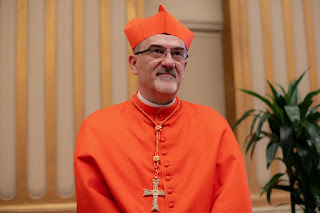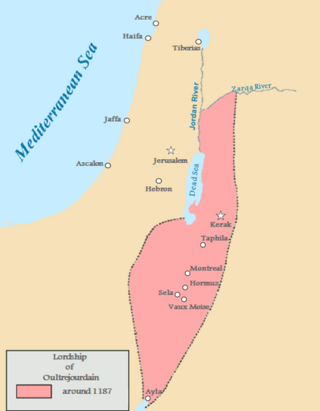Bishops
- Bernard (1131–1153)
- Amalric (c. 1153–1170)
- Odo (1175–1190)
- Raoul of Merencourt (1210–1214)
- Geoffrey Ardel (1236–1247)
- John of Saint Maxentius (1266–1267)
- Adam of Romery (c. 1274)
The Roman Catholic Diocese of Sidon was a bishopric in the Kingdom of Jerusalem in the 12th and 13th centuries.
Before the arrival of the crusaders to Syria in the late 11th century, the Orthodox bishops of Sidon had been suffragans of the archbishops of Tyre, who were in turn subject to the authority of the Orthodox patriarchs of Antioch. [1] [2] The first crusader king of Jerusalem, Baldwin I captured Sidon with the assistance of Venetian and Norwegian fleets on 5 December 1110. [3] He wanted to ensure that all sees in his kingdom were subject to the Latin patriarchs of Jerusalem. [4] He and Patriarch Ghibbelin, Latin Patriarch of Jerusalem, asked Pope Paschal II to authorize the expansion of the jurisdiction of the see of Jerusalem to include the diocese of Sidon. [4] [5] The Pope accepted their proposal and declared in 1111 that the boundaries of the ecclesiastic provinces should follow the political borders, making Sidon subject to Jerusalem. [5] However, the patriarchs of Antioch, Bernard of Valence, lodged an objection with the Holy See and prevented the appointment of a bishop subject to Jerusalem at Sidon. [5]
From the 14th-century, the Sidon became a Titular see. [6]

Patriarchate is an ecclesiological term in Christianity, designating the office and jurisdiction of an ecclesiastical patriarch. According to Christian tradition three patriarchates were established by the apostles as apostolic sees in the 1st century: Rome, Antioch, and Alexandria. Constantinople was added in the 4th century and Jerusalem in the 5th century. Eventually, together, these five were recognised as the pentarchy by the Council of Chalcedon in 451.

The Latin Patriarchate of Constantinople was an office established as a result of the Fourth Crusade and its conquest of Constantinople in 1204. It was a Roman Catholic replacement for the Eastern Orthodox Ecumenical Patriarchate of Constantinople and remained in the city until the reconquest of Constantinople by the Byzantines in 1261, whereupon it became a titular see. The office was abolished in 1964.

The Latin Patriarchate of Jerusalem is the Latin Catholic ecclesiastical patriarchate in Jerusalem, officially seated in the Church of the Holy Sepulchre. It was originally established in 1099, with the Kingdom of Jerusalem encompassing the territories in the Holy Land newly conquered by the First Crusade. From 1374 to 1847 it was a titular see, with the patriarchs of Jerusalem being based at the Basilica di San Lorenzo fuori le Mura in Rome. Pope Pius IX re-established a resident Latin patriarch in 1847.
The Patriarch of Antioch is a traditional title held by the bishop of Antioch. As the traditional "overseer" of the first gentile Christian community, the position has been of prime importance in Pauline Christianity from its earliest period. This diocese is one of the few for which the names of its bishops from the apostolic beginnings have been preserved. Today five churches use the title of patriarch of Antioch: one Oriental Orthodox ; three Eastern Catholic ; and one Eastern Orthodox.

The Latin patriarch of Antioch was a prelate of the Latin Church created in 1098 by Bohemond I of Taranto, founder of the Principality of Antioch, one of the crusader states.

The Melkite Greek Catholic Church, or Melkite Byzantine Catholic Church, is an Eastern Catholic church in full communion with the Holy See as part of the worldwide Catholic Church. Its chief pastor is Patriarch Youssef Absi, headquartered at the Cathedral of Our Lady of the Dormition in Damascus, Syria. The Melkites, who are Byzantine Rite Catholics, trace their history to the early Christians of Antioch, formerly part of Syria and now in Turkey, of the 1st century AD, where Christianity was introduced by Saint Peter.
The See of Tyre was one of the most ancient dioceses in Christianity. The existence of a Christian community there in the time of Saint Paul is mentioned in the Acts of the Apostles. Seated at Tyre, which was the capital of the Roman province of Phoenicia Prima, the bishopric was a metropolitan see. Its position was briefly challenged by the see of Berytus in the mid-5th century; but after 480/1 the metropolitan of Tyre established himself as the first (protothronos) of all those subject to the Patriarch of Antioch.
The archiepiscopal see of Caesarea in Palaestina, also known as Caesarea Maritima, is now a metropolitan see of the Eastern Orthodox Patriarchate of Jerusalem and also a titular see of the Catholic Church. It was one of the earliest Christian bishoprics, and was a metropolitan see at the time of the First Council of Nicaea, but was later subjected to the Patriarchate of Jerusalem. The city remained largely Christian until the Crusades, its bishop maintaining close ties to the Byzantine Empire. After the establishment of the Kingdom of Jerusalem by the crusaders, the see was transformed into a Latin archdiocese, subordinate to the Latin patriarch of Jerusalem.

Aimery or Aymery of Limoges, also Aimericus in Latin, Aimerikos in Greek and Hemri in Armenian, was a Roman Catholic ecclesiarch in Frankish Outremer and the fourth Latin Patriarch of Antioch from c. 1140 until his death. Throughout his lengthy episcopate he was the most powerful figure in the Principality of Antioch after the princes, and often entered into conflict with them. He was also one of the most notable intellectuals to rise in the Latin East.
The See or Diocese of Bethlehem was a diocese in the Roman Catholic Church during the Crusades and is now a titular see. It was associated with the Roman Catholic Diocese of Nevers.
The Apostolic Vicariate of Beirut is a Latin Church ecclesiastical jurisdiction or apostolic vicariate of the Catholic Church in Lebanon, where Eastern Catholics are far more numerous. In 2010, there were 15,000 baptized. Its current bishop is Cesar Essayan.

Guerricus was the metropolitan archbishop of Petra from 1167 or 1168 until his death at the Siege of Acre in 1190 or 1191. He was the only archbishop of Petra from the Crusader period and its only Latin Catholic bishop from the Middle Ages. Politically, his see belonged to the Kingdom of Jerusalem and roughly corresponded geographically to the secular Lordship of Oultrejordain.

The timeline of the Kingdom of Jerusalem presents important events in the history of the Kingdom of Jerusalem—a Crusader state in modern day Israel and Jordan—in chronological order. The kingdom was established after the First Crusade in 1099. Its first ruler Godfrey of Bouillon did not take the title of king and swore fealty to the Latin Patriarch of Jerusalem, Daimbert. Godfrey's brother and successor Baldwin I was crowned the first king of Jerusalem without doing homage to the patriarch in 1100. By 1153, Baldwin I and his successors captured all towns on the Palestinian coast with the support of Pisan, Genoese and Venetian fleets and also took control of the caravan routes between Egypt and Syria. The kings regularly administered other crusader states—the Counties of Edessa and Tripoli and the Principality of Antioch—on behalf of their absent or underage rulers.

The timeline of the Principality of Antioch is a chronological list of events of the history of the Principality of Antioch.
The Roman Catholic Archdiocese of Tyre was an archbishopric in the Kingdom of Jerusalem.
The Roman Catholic Archdiocese of Apamea was an ecclesiastical province of the Catholic Church in the Principality of Antioch from around 1110 to 1149.
William I was the second Latin archbishop of Tyre from 1128 until 1134 or 1135. He was originally from England and served as prior of the Church of the Holy Sepulchre before his appointment as archbishop.
The Latin Diocese of Tripoli was established in 1104 in the aftermath of the First Crusade. It remained a residential bishopric until 1289, after which it became a titular bishopric, which it remains today in the Catholic Church.
Latin Diocese of Tortosa in Syria was a Roman Catholic diocese established in the Syrian city of Tartus after the First Crusade. It had a resident bishop between 1128 and 1291. The cathedral of Tortosa became the site of a Marian shrine.
The diocese of Marash was an ecclesiastical jurisdiction in eastern Cilicia with its seat in the city of Marash. By the sixth century, it was an autocephalous archbishopric, but it fell into desuetude after the Arab conquest in the seventh century. The archdiocese was never revived.